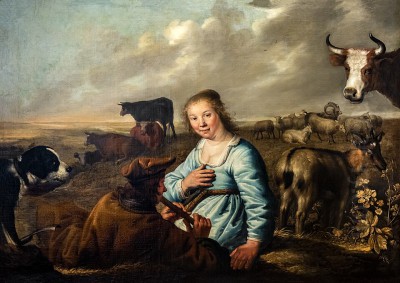
Jacob Gerritsz. Cuyp (1594–1651/1652) stands as a significant figure in the rich tapestry of Dutch Golden Age painting. Born and primarily active in the prosperous city of Dordrecht, he was a versatile artist known for his portraiture, landscapes, historical scenes, and depictions of animals. While perhaps overshadowed in popular recognition by his even more famous son, Aelbert Cuyp, Jacob Gerritsz. Cuyp was a foundational artist in his own right, contributing substantially to the artistic identity of Dordrecht and leaving behind a legacy of finely crafted works. His life and career offer insight into the artistic training, professional networks, and thematic concerns of painters during this vibrant period in Dutch history.
An Artistic Dynasty in Dordrecht
Jacob Gerritsz. Cuyp hailed from a family deeply rooted in the arts. Artistic skill appears to have been a generational trait. His grandfather, Gerrit Gerritsz. Cuyp, was reportedly a designer of stained glass, a respected craft demanding precision and an understanding of light and color. This tradition was continued by Jacob's uncle, Benjamin Gerritsz. Cuyp, who also worked as a stained-glass artist. Jacob's own father, also named Gerrit Gerritsz. Cuyp according to some sources provided, transitioned towards panel painting, specializing in portraiture. This environment undoubtedly fostered Jacob's early inclination towards the visual arts.
The artistic lineage extended through Jacob himself. He became the primary teacher of his son, Aelbert Cuyp (1620–1691), who would rise to become one of the most celebrated landscape painters of the Dutch Golden Age. Jacob likely imparted foundational techniques, particularly in figure drawing and perhaps the initial approaches to landscape backgrounds that Aelbert would later develop so masterfully. The family also included Jacob's nephew, another Benjamin Gerritsz. Cuyp (1612–1652), who became a notable painter known for genre scenes, landscapes, and biblical subjects, demonstrating the breadth of artistic practice within the extended Cuyp family.
Formative Years and Utrecht Connections
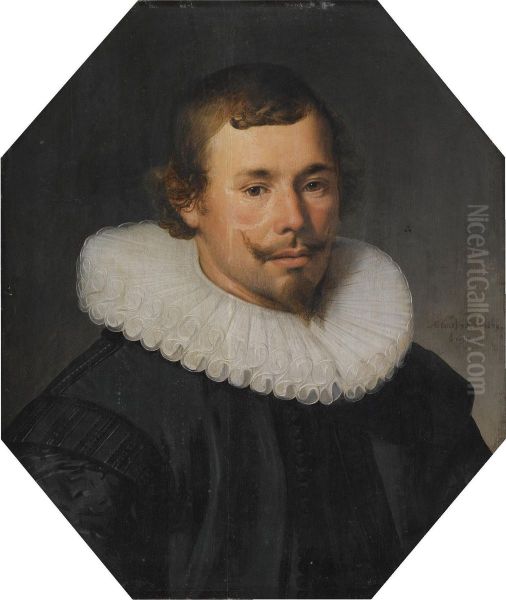
To refine his skills beyond the initial training likely received from his father, Jacob Gerritsz. Cuyp sought instruction from a leading master of the time. He traveled to Utrecht to study under Abraham Bloemaert (c. 1566–1651). Bloemaert was a highly influential painter and draftsman, known for his Mannerist roots evolving into a Baroque style, and importantly, he was a key figure in Utrecht painting. He ran a large and successful workshop, training numerous artists, including some who would become associated with the Utrecht Caravaggisti, and even, briefly, the great Rembrandt van Rijn.
Under Bloemaert, Cuyp would have absorbed lessons in composition, figure drawing, and color theory. Bloemaert was known for his facility with various subjects, including history painting, landscape, and genre scenes, which likely encouraged Cuyp's own versatility. The provided texts suggest Bloemaert imparted a preference for soft, harmonious color palettes, a characteristic that can sometimes be discerned in Jacob's work, offering a counterpoint to the more dramatic lighting effects he also employed.
The artistic environment in Utrecht during Cuyp's training period was particularly dynamic. It was a center for the Dutch followers of the Italian Baroque painter Michelangelo Merisi da Caravaggio. Artists like Hendrick ter Brugghen (1588–1629) and Gerard van Honthorst were popularizing the use of dramatic chiaroscuro – strong contrasts between light and shadow – often applied to religious and genre subjects. While Jacob Cuyp is not strictly classified as a Utrecht Caravaggisto, the influence of this approach, particularly the heightened sense of realism and dramatic potential offered by controlled lighting, is evident in aspects of his work.
Upon completing his training, Jacob Gerritsz. Cuyp returned to his native Dordrecht. He established himself as an independent master and, in 1617, joined the local Guild of Saint Luke. Membership in the guild was essential for practicing professionally, regulating trade, ensuring quality standards, and providing a framework for training apprentices. Cuyp would become deeply involved in the guild's activities throughout his career.
Versatility in Genre and Subject
Jacob Gerritsz. Cuyp demonstrated considerable range in his artistic output. He was not limited to a single specialty but tackled various genres popular in the Dutch market. Portraiture was a significant part of his oeuvre. He painted likenesses of Dordrecht's citizens, often displaying a straightforward, honest approach characteristic of Dutch portraiture. He seems to have had a particular affinity for painting children, often depicting them in fine attire, sometimes holding attributes like flowers or shepherds' crooks, lending a charming formality to these works. His attention to the details of costume and the individual features of his young sitters is notable.

Landscape painting also formed a crucial part of his work. While his son Aelbert would become famous for light-drenched, atmospheric river scenes, Jacob G. Cuyp also painted the Dutch countryside. His landscapes often feature pastoral themes, incorporating shepherds, cattle, and sheep. These works showcase his skills in depicting animals with anatomical accuracy and capturing the tranquil, agrarian life valued by his contemporaries. His approach often involved careful observation of nature, rendered with a solid, grounded realism.
History painting, encompassing biblical and mythological subjects, was another area of activity for Cuyp. Though perhaps less numerous than his portraits or landscapes, these works allowed him to engage with narrative and complex figure compositions, often drawing on the skills honed under Bloemaert. His collaborations, particularly with Ferdinand Bol, sometimes involved religious themes, indicating his capability and interest in this prestigious genre.
Furthermore, Cuyp engaged with animal painting not just as elements within landscapes but sometimes as the primary focus. His depictions of cattle and sheep, often rendered with careful attention to their forms and textures, reflect the importance of agriculture in the Dutch economy and psyche. Some sources also mention still life painting as part of his repertoire, rounding out his profile as a truly versatile Golden Age master.
Defining Stylistic Traits
Jacob Gerritsz. Cuyp's style is characterized by a blend of influences synthesized into a distinct artistic identity. A foundation of solid draftsmanship and careful observation underpins his work across all genres. His figures are typically well-defined, and his rendering of textures, whether the fabric of clothing, the fur of an animal, or the foliage in a landscape, demonstrates meticulous attention to detail.
His use of light and shadow is a key feature. Influenced perhaps by his time in Utrecht and the pervasive impact of Caravaggism, Cuyp often employed controlled lighting to model forms and create a sense of volume and drama. This is not always the stark, theatrical chiaroscuro of the most dedicated Caravaggisti, but rather a more moderated use of light to enhance realism and focus attention. In some works, particularly landscapes featuring animals, a sensitivity to natural light effects, perhaps hinting at the atmospheric concerns his son would later master, can be observed.
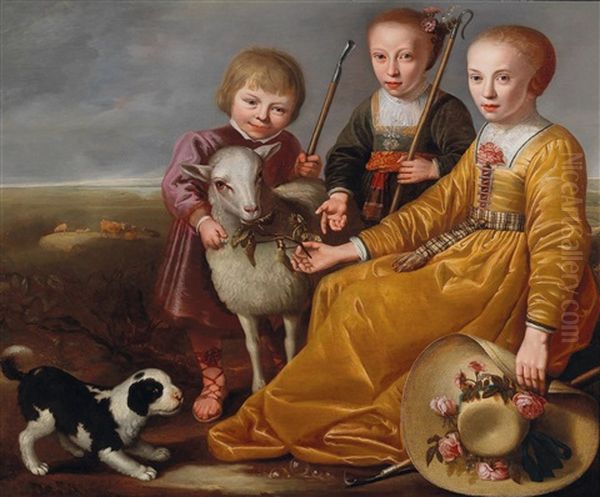
In terms of color, while sometimes employing the softer harmonies associated with his teacher Bloemaert, Cuyp could also utilize stronger, more grounded palettes. His portraits often feature the sober blacks, whites, and grays common in Dutch portraiture of the period, emphasizing form and likeness over decorative color. In his landscapes and animal paintings, earthy tones often dominate, contributing to the naturalistic feel of the scenes.
Compared to the often more idealized or Italianate landscapes emerging elsewhere, Cuyp's work generally maintains a strong connection to Dutch realism. His depictions feel tangible and specific, rooted in the observation of his local environment and its inhabitants. This commitment to realistic representation, combined with competent technique and a versatile approach to subject matter, defined his contribution to the Dordrecht school of painting.
Notable Works and Themes
While a comprehensive catalogue is complex, certain works and themes are frequently associated with Jacob Gerritsz. Cuyp. His portraits of children stand out as a recurring and successful subject. These paintings capture the seriousness and individuality of the young sitters, often depicted full-length or three-quarter length, adorned in the formal clothing of the era. The combination of detailed rendering and a degree of psychological insight makes these portraits compelling.
In the realm of landscape and animal painting, works depicting shepherds with their flocks are characteristic. Titles like Shepherds and Sheep or Shepherd with Cattle appear, showcasing his skill in rendering animals realistically within a pastoral setting. One specific work mentioned in the provided text is Shepherd with Cattle (dated 1655-1660 in the source, though this date range extends beyond Jacob's likely death; it might refer to a work by Aelbert or represent a point of attribution confusion). These paintings often emphasize a peaceful coexistence between humans, animals, and nature.
Another specific work mentioned is A Carpenter's Lunch (dated c. 1618-1629 in the source). This title suggests a genre scene, depicting an everyday activity. Such works align with the broader Dutch interest in representing daily life. If accurately attributed, it would point to Cuyp's engagement with genre painting early in his career, capturing moments of ordinary existence with the same careful observation applied to his portraits and landscapes. The depiction of a tradesman in a potentially rustic or natural setting would combine elements of genre, portraiture, and landscape.
Civic and Guild Activities
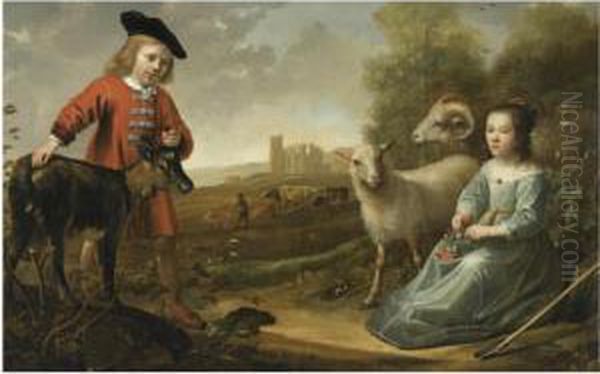
Jacob Gerritsz. Cuyp was not only a practicing artist but also an active member of the Dordrecht artistic community. His involvement with the Guild of Saint Luke was significant. The provided texts highlight his role as one of the founders who helped re-establish or reorganize the guild in 1642. This initiative aimed to elevate the status and regulate the practice of painting and related crafts in the city.
He collaborated in this effort with fellow artists Jacques de Claeuw, Isaac van Haestens, and Cornelis Tegelberg. This act demonstrates leadership and a commitment to the professional organization of artists in Dordrecht. Beyond founding, Cuyp also served the guild in official capacities, holding positions such as secretary and treasurer at various times. These roles would have involved administrative duties, managing finances, maintaining records, and potentially mediating disputes, indicating the respect he commanded among his peers.
His active participation in the guild underscores the importance of these institutions in the Dutch Golden Age. They provided structure, training standards, and a collective voice for artists. Cuyp's dedication suggests he was invested not only in his own career but also in the broader health and reputation of the artistic profession in his hometown.
Teaching and Collaboration
As a respected master, Jacob Gerritsz. Cuyp naturally took on pupils. His most famous student was undoubtedly his own son, Aelbert Cuyp. Jacob provided Aelbert's foundational training, teaching him the essential skills of drawing, painting, and composition. Given Jacob's proficiency in various genres, Aelbert received a well-rounded artistic education. Jacob's skill in depicting figures and animals likely formed a crucial base upon which Aelbert built his landscape-focused career, often populating his scenes with beautifully rendered cattle and people.
Beyond his son, the provided texts mention a close association and potential collaboration with Ferdinand Bol (1616–1680). Bol, who spent significant time in Rembrandt's workshop in Amsterdam, was a successful painter in his own right, known for portraits and history paintings. The sources suggest joint works between Cuyp and Bol, possibly dating from the late 1620s to early 1630s, potentially focusing on religious or historical subjects. Such collaborations were not uncommon, allowing artists to combine their strengths. This connection also links Cuyp, albeit indirectly, to the influence of Rembrandt, whose dramatic lighting and psychological depth impacted many artists, including Bol.
Network of Contemporaries
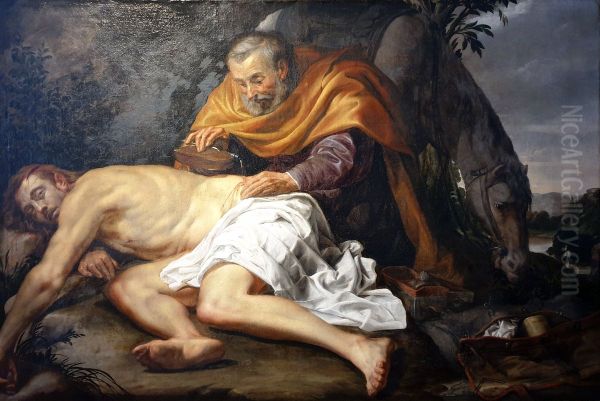
Jacob Gerritsz. Cuyp operated within a vibrant network of artists, both locally in Dordrecht and through wider connections. His training under Bloemaert and the influence of Utrecht Caravaggisti like Ter Brugghen placed him within broader artistic currents early in his career. His collaboration with Ferdinand Bol connected him to the Amsterdam art scene and the circle around Rembrandt.
The provided texts also mention stylistic links or shared influences with other prominent Dutch painters. Comparisons are drawn to the light effects or atmospheric qualities found in the works of artists like Jan Both (c. 1618–1652), known for his Italianate landscapes bathed in warm light, and Jan van Goyen (1596–1656), a pioneer of tonal landscape painting. While Cuyp's style remained distinct, these connections illustrate the shared artistic vocabulary and evolving interests among Dutch painters of the era, particularly concerning the depiction of light and landscape.
Within Dordrecht itself, he would have interacted with the artists he helped organize in the Guild of Saint Luke, including the aforementioned de Claeuw, van Haestens, and Tegelberg. The city, while perhaps not as large an art center as Amsterdam or Haarlem, supported a number of painters. The texts also mention Pieter de Hooch (1629–1684) and Gerard Dou (1613–1675) as contemporaries with whom Cuyp might have had some contact, although they are more strongly associated with Delft and Leiden, respectively. Mentioning them contextualizes Cuyp within the broader landscape of high-caliber Dutch Golden Age painting.
Later Years and Enduring Legacy
Sources suggest that in his later life, Jacob Gerritsz. Cuyp may have dedicated more time to religious and community affairs, potentially reducing his artistic output. His active role in the guild and possibly other civic duties might have taken precedence. He passed away in Dordrecht around 1651 or 1652.
Despite being somewhat eclipsed by the fame of his son Aelbert, Jacob Gerritsz. Cuyp's legacy is significant. He was a highly competent and versatile painter who played a crucial role in establishing a strong artistic tradition in Dordrecht. His portraits provide valuable records of the city's inhabitants, rendered with characteristic Dutch honesty. His landscapes and animal paintings contributed to the development of these genres, showcasing careful observation and solid technique.
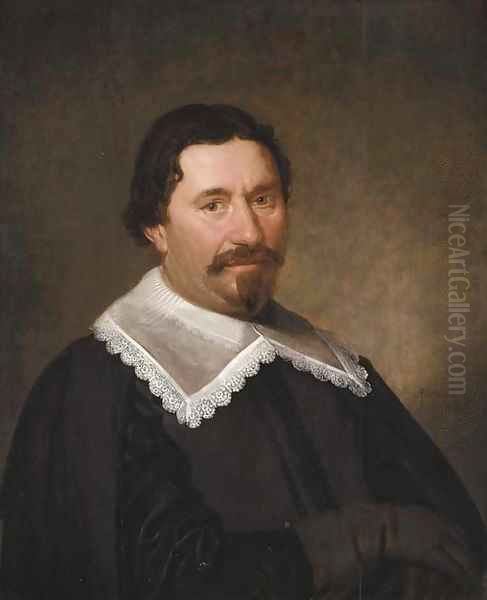
His role as a teacher, particularly to Aelbert, was pivotal. He provided the technical grounding that enabled his son's later innovations in atmospheric landscape painting. The similarity in style, especially in earlier works or in the rendering of figures and animals within landscapes, has sometimes led to attribution difficulties between father and son, highlighting their close artistic relationship.
Furthermore, the Cuyp family's influence extended through Jacob's nephew, Benjamin Gerritsz. Cuyp. Benjamin's own style, noted for its dynamism and sometimes rougher brushwork in genre and religious scenes, added another dimension to the family's output. His work, in turn, is said to have influenced later artists like Barent van der Meer, demonstrating the continuation of artistic impact. Jacob Gerritsz. Cuyp, therefore, stands as a central figure in a multi-generational artistic dynasty.
Conclusion
Jacob Gerritsz. Cuyp was more than just the father of a famous son; he was a cornerstone of the Dordrecht school of painting during the Dutch Golden Age. His extensive training under Abraham Bloemaert, combined with his engagement with the broader artistic trends of his time, including the influence of Utrecht Caravaggism, shaped him into a versatile and skilled master. Excelling in portraiture, particularly of children, as well as landscape, history, and animal painting, he demonstrated a commitment to realism, careful observation, and solid technique. His active role in the Guild of Saint Luke and his teaching activities further solidified his importance within the artistic community. While Aelbert Cuyp may have achieved greater renown for his luminous landscapes, Jacob Gerritsz. Cuyp laid the essential groundwork, establishing a high standard of painting in Dordrecht and leaving behind a body of work that reflects the artistic richness and cultural values of his time.